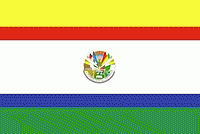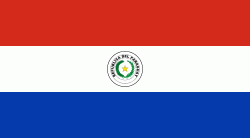Misiones Department (Departamento de Misiones)
 |
 |
Misiones borders the departments of Paraguarí and Caazapá to the north, Itapúa to the east, Ñeembucú to the west, and the Corrientes Province of Argentina to the south.
The modern settling of Misiones began with the arrival of Jesuit missionaries to the region in the 17th century and the subsequent establishment of several reductions whose purpose was to both civilize and catechize the indigenous Guaraní peoples. While several of these reductions would ultimately be in Argentinian and Brazilian territory, 8 of the reductions would remain in Paraguay, concentrated in what would become the Misiones and Itapúa departments. Some of these reductions, namely San Ignacio Guazú, Santa Maria de Fe and Santiago would become the foundation for subsequent towns in Misiones.
The town of Yabebyry was established in 1790, and later, during the presidency of Carlos Antonio López, the towns of San Miguel and San Juan Bautista were founded. When the Misiones department was created in 1906 as the San Ignacio department, these towns were made several of the department's first 8 districts, along with Santa Rosa, Ayolas and Villa Florida. When the department was renamed in 1945, its capital was moved from San Ignacio to San Juan Bautista.
Map - Misiones Department (Departamento de Misiones)
Map
Country - Paraguay
 |
 |
| Flag of Paraguay | |
Spanish conquistadores arrived in 1524, and in 1537 established the city of Asunción, the first capital of the Governorate of the Río de la Plata. During the 17th century, Paraguay was the center of Jesuit missions, where the native Guaraní people were converted to Christianity and introduced to European culture. After the expulsion of the Jesuits from Spanish territories in 1767, Paraguay increasingly became a peripheral colony, with few urban centers and settlers. Following independence from Spain in the early 19th century, Paraguay was ruled by a series of authoritarian governments characterized by nationalist, isolationist and protectionist policies. This period ended with the disastrous Paraguayan War (1864–70), during which the country lost half its prewar population and around 25–33% of its territory to the Triple Alliance of Argentina, Brazil and Uruguay. In the 20th century, Paraguay faced another major international conflict—the Chaco War (1932–35) against Bolivia—in which it prevailed. Afterwards, the country came under a succession of military dictators, culminating in the 35-year regime of Alfredo Stroessner, which lasted until his overthrow in 1989 by an internal military coup. This marked the beginning of Paraguay's democratic era, which continues to this day.
Currency / Language
| ISO | Currency | Symbol | Significant figures |
|---|---|---|---|
| PYG | Paraguayan guaranà | ₲ | 0 |
| ISO | Language |
|---|---|
| GN | Guarani language |
| ES | Spanish language |















